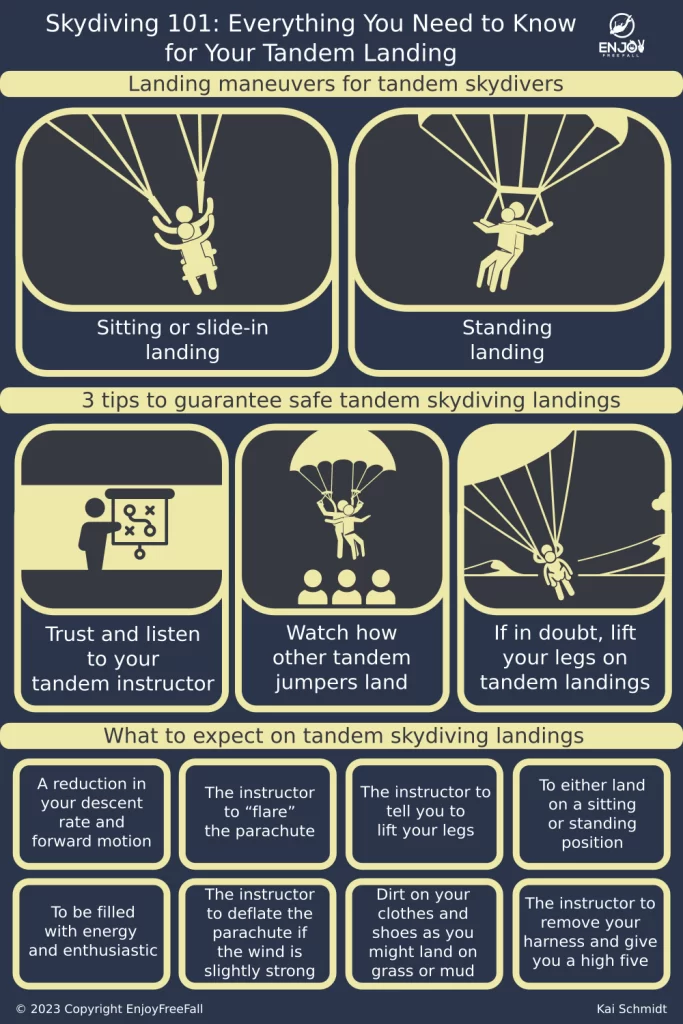
Jumping out of an airplane at above 10,000 ft is scary and nerve-wracking, especially for first-time jumpers. However, exiting the airplane is not the most dangerous part of skydiving. Most injuries are caused by improper landings, so how do you land during a tandem skydiving?
There are two types of landing during tandem skydiving, a sitting or slide-in landing wherein you land on your buttocks and a standing landing wherein you land on your feet. The tandem instructor determines the right landing approach depending on several factors including wind, ground conditions, and experience of the student.
Tandem instructors are responsible for the safety of the tandem students before, during, and after the jump. However, they rely on the cooperation of the student and even the best skydiving instructor cannot avoid injuries if the tandem student makes crucial mistakes.
In this article, I, therefore, explain everything you need to know about tandem landings including what mistakes you should avoid, if landings are bad for your knees and how fast you hit the ground during the landing.
How to Land Skydiving Tandem
In skydiving, landing is considered the most dangerous part. Based on studies, about 84% of skydiving injuries or fatalities were caused by a hard landing, while 9% were caused by a human error during the opening of the canopy. Here are the two types of landing performed during a tandem skydive.
Sitting or Slide-In Landing During Tandem Skydiving
This is the most common landing position that tandem instructors perform. It can be done with the help of the tandem students; they just need to simply lift their legs in front of themselves with their toes pointing in the sky. The tandem instructors will also do the same, and then they will both slide on their backsides or buttocks until they come to a stop.
It is also considered the safest landing position because tandem pairs become less prone to injuries such as ankle and knee sprains, ligament tear, and contusions. It is crucial to wait until you come to a full stop before trying to put your legs down, as this could otherwise make you or your instructor fall over. The best option is to wait until your tandem instructor tells you to stand up.
You also need to expect a few specks of dirt on your clothing once you hit the ground. Most landing areas are made of grass and can be muddy in some parts. That’s why it is advisable to wear clothing that is ok to get dirty. The skydiving company will probably also give you a jumpsuit that will protect your clothes and make you look professional.
If you are interested in knowing more about the five things to wear and not to wear for your tandem jump, check out this article.
Standing Landing During Tandem Skydiving
Standing landing is another technique used for skydiving. However, it is widely used by experienced solo skydivers and only occasionally by tandem jumpers. The ground conditions must be conducive to perfectly execute this type of landing.
To perform this, tandem instructors will determine if the speed and their position are suitable for a standing landing. Tandem instructors will steer the canopy to the ground and start walking or running. Once their feet are stable on the ground, they will inform the student that they can put their feet down.
As a gentle reminder for tandem students, do not stand or put your feet down unless your instructor told you to do so. Otherwise, your tandem instructor will not expect you to do so and might fall over you. This can result in an unforeseen accident or injury for the tandem student and the instructor.
Tandem instructors also consider the number of jumps performed by a tandem student. A standing landing is most likely not ideal for first-time skydivers since they still have not experienced an actual landing. You need to have a fair share of experience to properly execute this position.
I know a few experienced skydivers that still experience difficulty in performing such standing landing when they jump tandem.
Three Tips to Guarantee Safe Tandem Skydiving Landings
Before skydiving, you might be filled with a lot of nervous energy. Try to relax and remain focused during the entire briefing and 1 on 1 session with your tandem instructor. To give you a heads up, here are the top three tips on how you can safely land during a tandem jump.
Trust and Listen to Your Tandem Instructor
As a tandem student, you need to trust your tandem instructor. They are trained and experienced individuals who completed rigorous training and performed at least 500 jumps before they could be certified as tandem instructors.
If you want to learn more about the experience of tandem instructors, check out my article about the requirements to become a tandem instructor! It demystifies the job and will make you feel much safer during your next tandem jump!
It is crucial to listen to your tandem instructors. Most especially when they give instructions on the right body position under the canopy and when they tell you to lift your legs during the landing procedure. The biggest reason why we still have accidents in skydiving is because of human error. Every now and then, someone tries something new or deviates from the safety requirements which leads to accidents and injuries.
Listening to the instruction of your tandem instructor will help avoid any untoward injuries and hard landings.
Besides, you should try to never panic during your (tandem) skydive. If there is any malfunction or problem with the parachute, your tandem instructor is perfectly qualified to solve it – and he will solve it.
One of the reasons why the recommended parachute deployment height for tandem jumps is more than 1,500ft higher than for solo skydives is because the tandem instructor will have around 15 seconds more to resolve it.
If for any reason the main canopy does not deploy properly, there is also always a reserve parachute that tandem instructors can deploy, or it will automatically open at a preset altitude.
Watch How Other Tandem Jumpers Land
If you are still unsure about how your jump and landing will happen, it is recommended that you arrive at the dropzone 30-45 minutes earlier than your appointment. You can spend the time watching how other tandem jumpers land.
You might be able to pick some tips and tricks from experienced skydivers on how it is done properly. Some people are visual learners, meaning they prefer to see the actual process before they can replicate it.
The wait time for your check-in can vary from 45 minutes on weekdays and to 90 minutes on weekends. It depends on how busy the dropzone is and how many clients show up late for their bookings but you can use that time to observe the landing of other skydivers and talk to experienced solo skydivers.
If you are lucky, you also might see competitive skydivers jumping and practicing their formations and routines. It will be a good time to see how skydiving experts perform those complicated jumps and still land safely to the ground.
If you want to know more about each step of the skydiving process and how long it takes, check out this article (which also includes tips to save wait time).
If You Are Not Sure What to Do: Lift Your Legs During Skydiving Landings
The main reason why you need to lift your legs is to reduce the risk of landing injuries. As a result, skydiving companies test your mobility before they allow you to jump.
Once you arrive at the dropzone, skydive staff will perform an on-site assessment. You might be asked to sit on the edge of a seat, pull your legs together and lift them in front of you. This will help them gauge your capacity to perform the landing procedure. It also allows the tandem instructors to make adjustments to your body position.
Once you exit the plane, you will experience a freefall speed of 120 mph, and as soon as the parachute is opened, it will descend to approximately 17 mph (27 kph). The tandem instructor will control the canopy to the landing area and try to slow down the speed as much as possible.
Sometimes first-time jumpers are so much under adrenaline that they do not hear the tandem instructor properly. If you are not sure what he said, and you are approaching the ground, lift your legs.
If you need extra support to lift your legs, you can put your hands at the back of your knees and pull them towards you. If you need any assistance in lifting your legs, your tandem instructors will also use their legs to support you.

What to Expect on Tandem Skydiving Landings?
Even though landing is the most dangerous part of skydiving, there is nothing to worry about if you follow the aforementioned tips. To ease your worries, here are the things that you can expect before, during, and after the tandem landing.
- Reduction in your descent rate and forward motion as you slowly approach the ground
- The tandem instructor will “flare” the parachute i.e. bringing the speed down to 1-6 mph
- The tandem instructor will tell you to lift your legs
- Depending on the conditions, you will either land on a sitting position or standing position
- You will be enthusiastic after the landing and filled with energy
- The tandem instructor will deflate the parachute if the wind is slightly strong to avoid being dragged around by the parachute
- Expect a few specks of dirt on your clothing and shoes since you might land on a grassy or muddy area of the dropzone
- The instructor will remove your harness and give you a high five
What Happens if You Fail to Lift Your Legs?
As mentioned earlier, most of the skydiving injuries happen due to wrong landings. Tandem instructors have full control over the entire jump. However, as a tandem student, you also have a responsibility to follow accordingly and perform the necessary movements for a safe landing.
If you fail to lift your legs, you might get injuries such as breaking an ankle or bones once you hit the ground hard. Are you curious about how likely you will get injured during a skydive? Check out my article about the true risks of skydiving. It will give you a mind-blowing, new perspective on the sport!
Another worst-case scenario is that you might stumble and fall on the ground due to the strong force of your impact, and your tandem instructor might fall over you.
If you have difficulties lifting your legs, tell your instructor and he will give you support with his own legs.
Rest assured that your tandem instructor will inform you once it is the right time to lift your legs; you will hear them say, “Legs up! Legs up! Legs up!”. Just focus on the task, and you will have the most amazing experience of your life.
It would be best to walk away unharmed after a life-changing jump. The key is to simply follow the instructions given by the tandem instructor during the briefing session and landing preparation.
How Hard Is the Landing When Skydiving?
Most landings during skydiving are very gentle since you will land either with your buttocks or feet. During tandem skydiving, instructors will mostly absorb the force of the impact, and you just need to cooperate and lift your legs as instructed.
It will only become a hard landing if you fail to lift your legs properly or if you encounter strong ground winds. You will most likely fall, and your tandem instructor might fall over you due to the force of the impact.
Landing speed can vary depending on the wind and how high you were from the ground when the landing procedure was executed. It normally ranges between 1 and 17 mph.
If you experience a hard landing and only walk away with a few scratches and bruises, then consider yourself lucky. Some experience more serious injuries that even require medical assistance or, worst, might result in fatalities.
According to USPA, in 2019, the report indicates that there are only 2,522 skydiving injuries that require medical assistance and 15 fatalities out of roughly 3.3 million jumps. It is equivalent to 1 injury out of 1,310 skydives, while fatalities are only 1 out of 220,301 jumps. Most of the injuries happened due to hard and improper landings.
In general, tandem skydiving is considered 2.5 times safer compared to solo skydiving. If you are interested to learn more about why tandem skydive is safer than solo skydiving, you can check this post.
Is Skydiving Bad for Your Knees?
Skydiving can be bad for your knees as well as other parts of your body. Landing requires skills. For tandem jumping, the tandem instructors are well trained to make sure that you will reach a soft landing.
Most of the time, instructors absorb a large portion of the impact. That’s why they prefer to use the sitting or slide-in landing to make sure that your knees won’t get in the way and you can walk away without a scratch.
Landings can be rough; that’s why skydivers were able to develop different ways and techniques on how to land safely over time. To avoid getting hurt badly, skydivers who could not properly execute and stand on their landings will perform a so-called “Parachute Landing Fall” (PLF).
It is a technique used to minimize the force of the impact when coming in for a landing. To do these, skydivers who fall feet down will just simply roll to their side. As a result, most pressure of the landing will be absorbed by harder parts of your body.
As you can imagine, PLFs are hard to perform as a tandem pair. Therefore, skydiving companies restrain from performing tandem jumps in strong winds or unreliable weather conditions because they often lead to uncontrolled landings.
How Fast Do You Hit the Ground in a Parachute?
Parachutes are designed to decrease your rate of descent to at least 85-90%. After jumping out of the aircraft, you and your tandem instructor will achieve a terminal velocity (i.e. maximum falling speed) at around 120 mph. Once the parachute has been deployed, your speed will significantly decrease to approximately 12-17 mph.
Modern parachutes have toggles and steer capabilities, which will help the skydivers even slow the speed down to at least 1-6 mph before initiating the landing maneuver. Most experienced skydivers can manage and land on their feet with this rate, while tandem jumpers are advised to do a sitting/slide-in position.
Several factors will affect how fast you will hit the ground, such as the type of canopy (whether it’s round or ram-air parachutes), the speed of the ground wind, and the canopy controlling skill of the pilots.
During landing, flaring slows the descent down while losing the forward speed and creating a soft touchdown. However, skydivers need to flare at the right height (not too high or not too low), which is generally between 12-15 ft above the ground.
In conclusion, skydiving involves risks. But with proper training and preparation, tandem instructors can minimize those risks and safely land you back to the ground. To help reduce the risk, you will also need to do your part as a tandem student and follow the safety protocols.
Enjoy your freefall!



